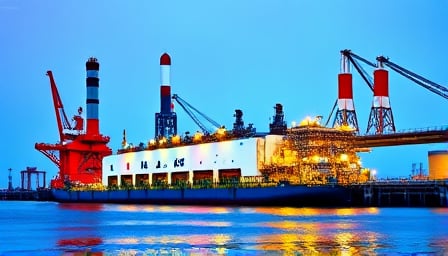Woodside Energy Group Ltd’s Strategic Positioning Amidst Global LNG Demand Growth
Woodside Energy Group Ltd, a prominent player in the petroleum exploration and production arena, has recently announced a series of developments that reinforce its strategic foothold within the evolving global energy landscape. The company’s executive leadership, under CEO Meg O’Neill, has articulated a clear vision for the future of liquefied natural gas (LNG), citing a projected 50 % increase in demand over the next decade. This optimism is anchored in two key dynamics: escalating global energy requirements and the broader shift toward cleaner, low‑carbon energy vectors.
1. LNG Demand Trajectory and Market Drivers
1.1 Global Energy Needs
World energy consumption is projected to rise by approximately 30 % by 2030, with developing economies in Asia and Africa driving much of that growth. LNG, as a transportable and relatively cleaner fossil fuel, is expected to play a pivotal role in bridging the supply‑demand gap during the transition to renewable sources. Woodside’s forecast aligns with independent analyses from the International Energy Agency (IEA) and the International Trade Administration, both of which anticipate a sustained uptick in LNG imports, particularly in regions with rapidly expanding electricity grids and industrial bases.
1.2 Transition to Cleaner Energy
Regulatory momentum toward decarbonisation—exemplified by the Paris Agreement, European Green Deal, and China’s carbon neutrality pledge—has increased the attractiveness of LNG as a “cleaner bridge” fuel. LNG emits roughly 30 % less CO₂ than coal and up to 60 % less than crude oil when used in power generation. Consequently, nations are seeking to diversify their gas supplies while investing in renewable infrastructure. This trend provides a favorable backdrop for Woodside’s expansion strategy.
2. Strategic Partnership with Petronas
2.1 Deal Overview
Woodside Energy’s 15‑year LNG supply agreement with Petronas Malaysia Berhad represents a significant milestone. Under the terms, Woodside will deliver LNG to Malaysia, ensuring a steady pipeline of natural gas that supports the country’s power sector during its renewable energy scaling. Petronas, Malaysia’s state‑owned oil and gas entity, is responsible for national energy security, and this partnership underscores the strategic alignment between Woodside’s supply capabilities and Petronas’s demand requirements.
2.2 Implications for Malaysia’s Energy Transition
Malaysia’s renewable energy targets—aiming for 20 % renewable content in electricity generation by 2025—necessitate reliable baseload support. LNG serves as a flexible, dispatchable source that can complement intermittent renewable generation. By securing long‑term contracts, Woodside not only diversifies its revenue streams but also gains a foothold in a Southeast Asian market that is poised for substantial infrastructure investment.
2.3 Risk Mitigation and Market Positioning
Long‑term contracts reduce market volatility exposure for both parties. For Woodside, the Petronas agreement locks in a predictable sales volume, mitigating price swings typical of spot LNG markets. Simultaneously, Petronas benefits from price stability and supply assurance, allowing it to better plan its energy mix and negotiate favorable terms with downstream utilities.
3. Financial Stability and Capital Strength
3.1 Share Price Dynamics
Woodside’s share price has demonstrated resilience amidst broader energy market volatility. While recent weeks have seen modest fluctuations—attributable to global commodity price swings and policy announcements—the underlying fundamentals remain robust.
3.2 Net Tangible Asset Base
The company’s net tangible assets, reported at approximately 84 cents per share after tax, indicate a substantial asset base relative to equity. This metric, derived from the balance sheet’s tangible assets minus intangible and goodwill, signals a healthy liquidity position that can absorb downturns and fund capital expenditures.
3.3 Capital Allocation and Growth Initiatives
Woodside’s capital allocation strategy emphasizes low‑risk, high‑yield projects, including the ongoing development of its onshore and offshore LNG facilities. The firm’s disciplined approach to debt management and dividend policy has preserved shareholder value while maintaining sufficient leverage for future expansion.
4. Cross‑Sector Synergies and Broader Economic Trends
4.1 Energy Infrastructure and Maritime Logistics
The LNG sector is intrinsically linked to maritime logistics. Woodside’s supply agreements necessitate efficient shipping routes and port infrastructure—areas where investment trends in Asia are rapidly evolving. Enhanced port capabilities, coupled with advancements in liquefaction technology, reduce transportation costs, thereby improving the competitiveness of LNG in price‑sensitive markets.
4.2 Technological Innovation in Renewable Integration
The integration of LNG with renewable energy systems—such as hybrid power plants and demand‑response schemes—creates new business opportunities. Woodside’s participation in such projects can diversify its portfolio beyond traditional LNG sales, positioning the company as a key enabler of low‑carbon power systems.
4.3 Macroeconomic Factors and Commodity Cycles
Oil and gas markets are sensitive to macroeconomic indicators including GDP growth, industrial activity, and monetary policy. Woodside’s diversified asset base and long‑term contracts cushion the company against cyclical downturns, while the projected LNG demand growth provides a counterbalancing upward trajectory.
5. Competitive Landscape
5.1 Key Players
Woodside competes with global LNG exporters such as QatarEnergy, Cheniere Energy, and Equinor. Each competitor leverages distinct strengths—QatarEnergy’s scale, Cheniere’s domestic US infrastructure, and Equinor’s diversified renewable portfolio. Woodside’s advantage lies in its strategic positioning within the Australian market, a region characterized by stable political governance and strong regulatory frameworks for energy projects.
5.2 Market Differentiation
The company’s focus on medium‑to‑large LNG projects, combined with its ability to secure long‑term contracts with national oil companies, differentiates it from smaller regional operators. Moreover, Woodside’s commitment to environmental stewardship—evidenced by its investment in carbon capture and storage (CCS) research—aligns with evolving regulatory expectations.
6. Conclusion
Woodside Energy Group Ltd is navigating an era marked by heightened demand for cleaner fossil fuels and a robust push toward renewable energy adoption. Through its leadership’s optimistic outlook on LNG demand, strategic partnership with Petronas, and solid financial underpinnings, the company is well positioned to capitalize on both immediate market opportunities and long‑term energy transition trends. By maintaining a disciplined approach to risk management, capital allocation, and cross‑sector collaboration, Woodside exemplifies how traditional energy firms can evolve to meet the imperatives of a low‑carbon future while preserving shareholder value.
